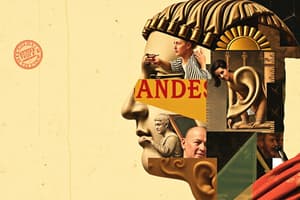Podcast
Questions and Answers
What are Cicero's five canons of rhetoric?
What are Cicero's five canons of rhetoric?
Inventio, Dispositio, Elocutio, Memoria, Pronuntiatio
What are the five canons of rhetoric stated by Aristotle?
What are the five canons of rhetoric stated by Aristotle?
- Style (correct)
- Arrangement (correct)
- Delivery (correct)
- Memory (correct)
- Invention (correct)
What were the five parts of a speech that Quintilian taught?
What were the five parts of a speech that Quintilian taught?
Exordium, Narratio, Confirmatio, Confutatio, Peroratio
What did Quintilian urge teachers to do?
What did Quintilian urge teachers to do?
What two qualities must be united in Cicero's view of an orator?
What two qualities must be united in Cicero's view of an orator?
Who was Hermagoras of Temnos?
Who was Hermagoras of Temnos?
What did Hermagoras's method provide the roots for?
What did Hermagoras's method provide the roots for?
What must speakers be wary of when using humor according to Cicero?
What must speakers be wary of when using humor according to Cicero?
What are some things that should not be made fun of?
What are some things that should not be made fun of?
What qualities help an author achieve sublimity according to Longinus?
What qualities help an author achieve sublimity according to Longinus?
Flashcards are hidden until you start studying
Study Notes
Cicero's Five Canons of Rhetoric
- Inventio: The process of discovering persuasive arguments.
- Dispositio: The effective arrangement and organization of arguments.
- Elocutio: The selection of appropriate language for delivering a speech.
- Memoria: The ability to remember and recite a speech accurately.
- Pronuntiatio: The dignified and controlled delivery of a speech, encompassing voice and body language.
Quintilian's Structure of Judicial Speeches
- Exordium: Introduction designed to engage and prepare the audience to listen.
- Narratio: Presentation of essential facts needed to understand the case at hand.
- Confirmatio: Provision of evidence supporting the claims made in the speech.
- Confutatio: Refutation section addressing and countering opposing arguments.
- Peroratio: Conclusion that reinforces the main arguments and the overall strength of the case.
Cicero's View on Eloquence and Wisdom
- Eloquence must be united with wisdom for effective oratory.
- Eloquence without wisdom lacks substance, while wisdom without eloquence is ineffective in influencing others.
- Cicero believed that eloquence rooted in wisdom contributes to the foundation of civilization, highlighting the importance of personal character.
Hermagoras of Temnos
- Significant figure in Roman rhetoric who classified judicial arguments into three categories: conjectural, legal, and juridical.
- Developed a method for argument analysis that distinguished between "thesis" (general premise) and "hypothesis" (specific conclusion derived from the thesis).
Seven Circumstances by Hermagoras
- Method of analysis framed around covering all aspects of a topic through questions: who, what, when, where, why, in what way, and by what means.
- This approach informs the "5 W's" used in modern journalism and investigations, promoting thorough examination of subjects.
Humor in Rhetoric
- Orators must balance humor with dignity, ensuring respect for audience sensibilities.
- Humor should not undermine the serious aspects of a speech or target sensitive topics.
- Cicero emphasized the importance of avoiding becoming a mere entertainer or buffoon while incorporating humor.
Qualities of Sublime Writing (Longinus)
- Longinus emphasized emotional impact as a measure of great writing.
- Identified five sources contributing to sublimity: vigor of thought, inspired emotion, effective use of figures, adequate style, and proper arrangement.
Studying That Suits You
Use AI to generate personalized quizzes and flashcards to suit your learning preferences.




